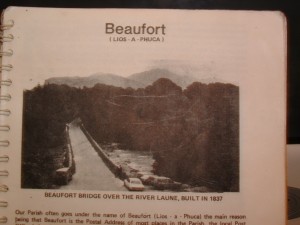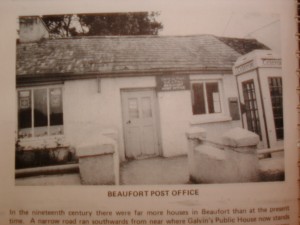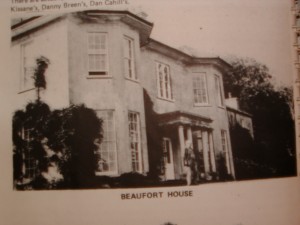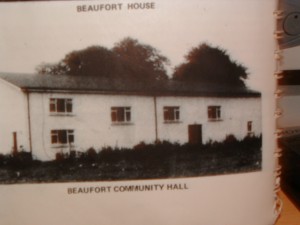Beaufort
(LIOS – A – PHUCA)
Beaufort Bridge over the river Laune built in 1837.
Our parish often goes under the name of Beaufort
(Lios – a – Phuca) the main reason being that Beaufort is the Postal Address of most places in the Parish, the local Post Office being situated in Beaufort.
Beaufort is a village at the very eastern end of the parish consisting of a Post Office, three public Houses, Garda Barrack, Smithy Garage, Creamery, two Supermarkets, Parish Hall, Guest Houses and thirty private houses with a population of about 130.
The name Beaufort for the district is really an anachronism as what is now called Beaufort is really part of the townland of Coolmagort and Beaufort really consists of the land in Beaufort Demesne which lies between the main road and the river Laune. It has a fine example of those ancient lioses as it consists of two circular earthen fences with a moat or fossel between them and must have been the residence of somebody of importance in those ancient days of the Tuatha De Danann. It is extraordinary how the earthen fences have withstood the ravages of wind and rain and of man and animals down through those hundreds of years.
Beaufort Demesne was divided between local farmers in 1912. The original owners of the plots reading from east were: Ned O’Sullivan, Jack Connor, Michael Galvin, Jim Coffey and Pats Scully.
According to Lewis “there was in 1837 a constabulary Police Station at Beaufort and Petty Sessions were held every three weeks at Coolmagort”. The Courthouse stood at the Chapel Cross, in Dan O’Shea’s field where an old shed stands now, many parishioners were tried and often got severe sentences for very petty crimes.
One famous case begun when Mike Tangney, Gearahmeen and his cousin Denis Tangney, the men were returned for trial for been involved in a shooting which took place in the Valley. The Tangneys were famous Moonlighters at the time of the Land League and the Land War. They were tried three times but on each occasion the jury disagreed and they were acquitted. The Petty Sessions continued there until 1919 or 1920 when Sinn Féin Courts took over.
In the Nineteenth century there was far more houses in Beaufort than at the present time. A narrow road ran southwards from near where Galvin’s Public House now stands and was connected to the Upper Road or Green Road. Along the road there are many houses where many craftsmen lived, carpenters, smiths, wheelwrithts, tailors. So many tailors lived there that at one time the village was known as “Tailor Street”.
In 1891 the great Parnell held an election meeting in Beaufort in the General Election of that year. The Parnell split was on and so he, Parnell was not allowed to hold a meeting in Killarney. The O’Donoghue who at the time was M.P. for South Kerry lived at Tomies and invited Parnell to speak in his own parish.
The meeting was held in Patrick O’Sullivan’s field south of Beaufort Bar. The meeting was a huge success as thousands came to see and hear him. In the end O’Donoghue did not vote for Parnell in the vital meeting in the House of Commons in 1891.
The present Garda Barracks was built in 1932. The old R.I.C. barrack stood where Shanahan’s shop now is. It was burnt by the I.R.A. IN 1920 when all rural barracks were evacuated. The Ball Alley was built in 1850 but was mostly demolished in 1973 to make way for the addition to the Public House.
In the summer of 1912, 1913, 1914 an American Company called The Kalems visited Beaufort and made Movie Pictures, Rory O’Moore and The Colleen Bawn which were the first movies made in Ireland. The outbreak of war in 1914 put an end to their activities.
The highest point in the area is Ardfergus (Ardfearghuis Hill or Kevin’s Leacca 200 feet above sea level) Ferris was the guardian of the river Laune under McCarthy Mor. His castle or Tower House was at Ballymalis. Also in the village was up to a very short time ago, a reminder of the bad old days and the “Soup Houses”, an old ruin stood where Jerry Mangan house stands. Those houses were built to provide soup for needy Catholics in famine times. It was also an attempt at Proselytising as one of the conditions for getting the soup, was that one should attend Protestant Service at least twice in the year, one time being Christmas Day. There is rather an amusing story told of a certain person names Kelliher who had a large family and found it hard to feed them. As a last resort he partook of the soup and went to Church on Christmas Day. During the singing of some hymns he joined in, but not knowing the hymns he poured fourth in an Irish song, not too pious, “An Clar Beag Deil”. He thought of course that nobody would understand his song, unluckily for him Mac Gillycuddy of the Reeks was present and he knew Irish well and heard what he thought was blasphemy and so poor Kelliher was banished from Church and Soup.
By the way, when speaking of the Protestant Church, the building, we always use the word “Church” but when speaking of the Catholic Church, we usually use the word “Chapel”.
St. Stephen’s Day was a great day or fiesta in Beaufort in the old days, pre. 1920. From an early hour people could be seen making towards the village on foot, in cars or even on bicycles in those days. About mid-day the village was absolutely thronged. Dancing was the principal past time – “set” dancing. The three public houses were choc full of dancers and the crowds over flowed out into the road and it was a common sight to see several “sets” being danced simultaneously on the public road. The ball alley was a favourite venue and catered for ten or twelve sets at the same time. Music was supplied by local musicians on melodeons or violins and all was free.
A game called “Batai Bui” was played by men in the fields at the back of the pubs. It was a very simple game and I have never heard of it being played anywhere else or on any other day. Two teams consisting of four or five men on each side took part and each player had a stick about the length of a walking stick “an ash plant” or an “ash growth”. A stick was stuck in the ground and each player in turn stood about twenty yards from the stick and threw his own stick at the standing one. The team who made most “hits” won the game. When nightfall came a completely different aspect of life was shown in the form of vicious faction fights. Old sores were resurrected and attempts to cure them gave rise to violence and even to bloodshed on some. There is the story of an old man who had to use a crutch to help him walk, and on hearing the clock in the pub strike seven, was heard to exclaim “seven o’clock and not a stroke struck yet” and wielding his crutch struck the first person whom he thought he did not like and so began a sort of “free for all”. Today however, the scene has changed and gone is the dancing and the “Batai bui” which we regret and with them also went the violent faction fights which nobody regrets. The village underwent very little change down through the years until about twelve years ago. James Carson had bought half Jack Connor’s farm in 1954 and in 1971 Darby Guerin bought the other half and the Public House. He built the “Inn Between” a fine lounge bar on the old pub site and built many houses on the farm including his own dwelling and a fine supermarket.
There are actually five other fine shops in the area – Shanahan’s, Mrs. Harrington’s, John Kissane’s,




